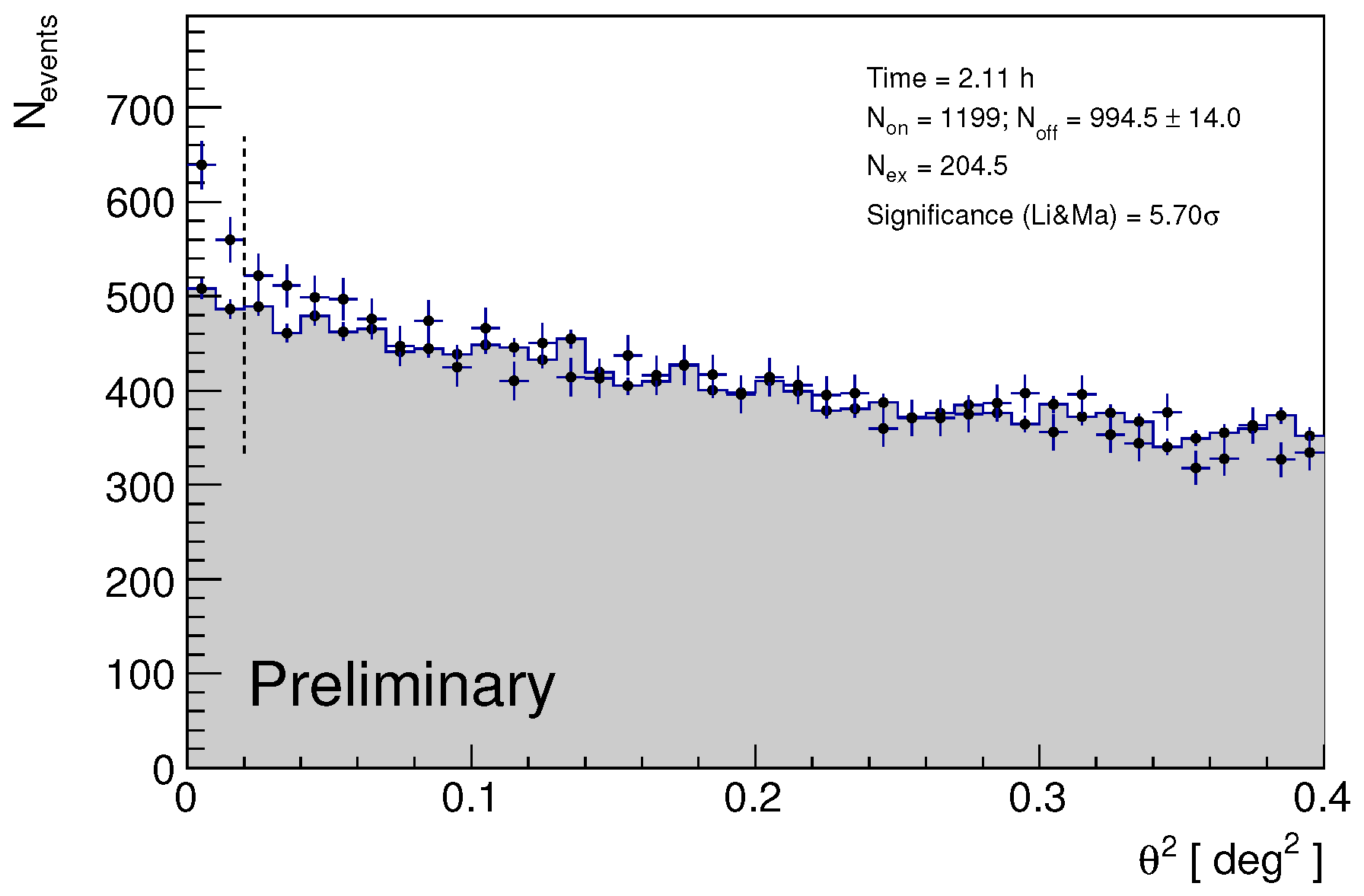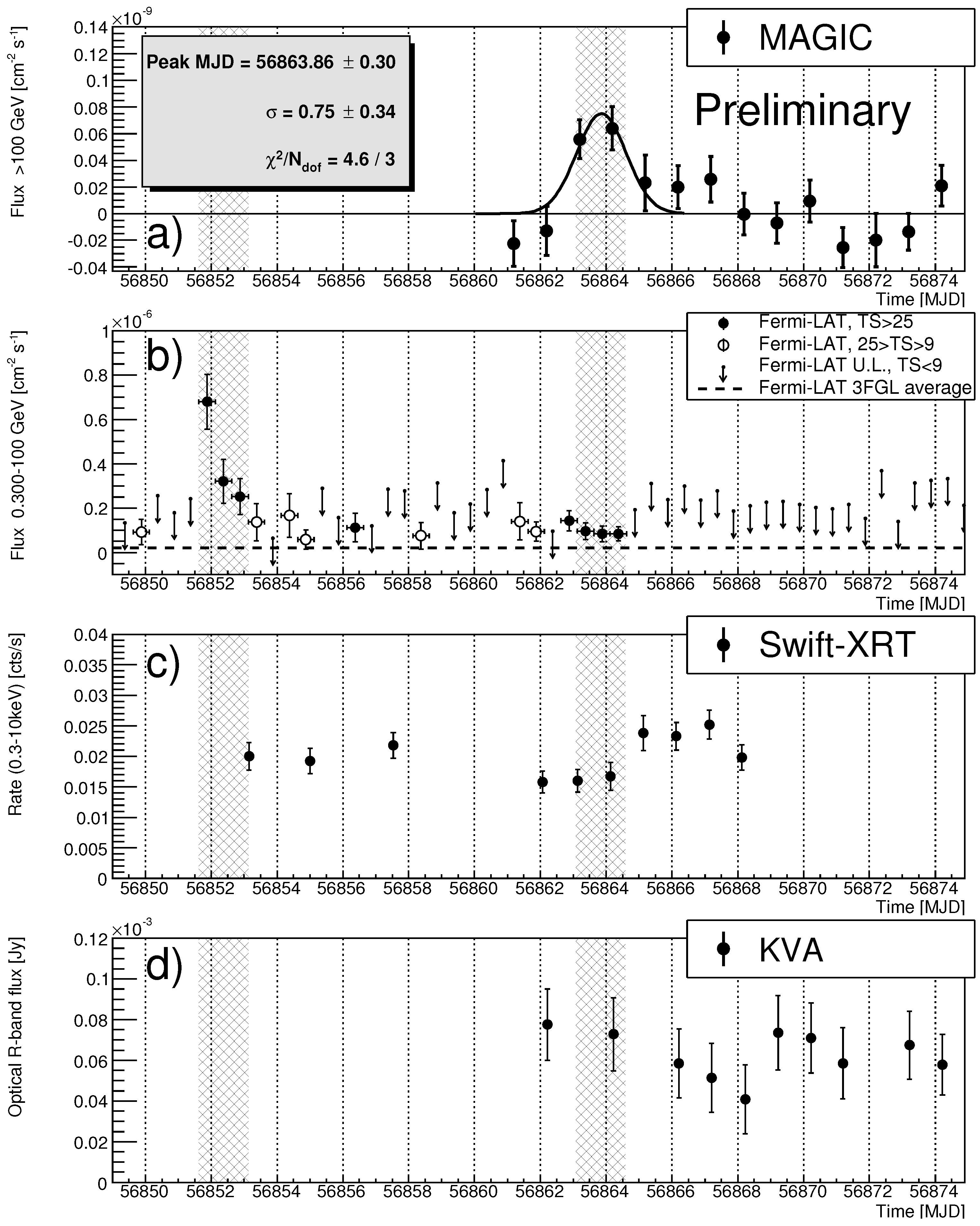Broad Band Observations of Gravitationally Lensed Blazar during a Gamma-Ray Outburst
Abstract
:1. Introduction
2. Observations and Data Analysis
3. Results
4. Discussion
Acknowledgments
Author Contributions
Conflicts of Interest
References
- Mirzoyan, R. Discovery of Very High Energy Gamma-Ray Emission From Gravitationally Lensed Blazar S3 0218+357 With the MAGIC Telescopes. Astron. Telegr. 2014, 6349. Available online: http://www.astronomerstelegram.org/?read=6349 (accessed on 9 September 2016). [Google Scholar]
- Ahnen, M.L.; Ansoldi, S.; Antonelli, A.; Antoranz, P.; Babic, A.; Banerjee, B.; Bangale, P.; de Almeida, U.B.; Barrio, J.A.; Bednarek, W.; et al. Very High Energy γ-Rays from the Universe’s Middle Age: Detection of the z = 0.940 Blazar PKS 1441+25 with MAGIC. Astrophys. J. Lett. 2015, 815, L23. [Google Scholar] [CrossRef]
- Ackermann, M.; Ajello, M.; Allafort, A.; Antolini, E.; Atwood, W.B.; Axelsson, M.; Baldini, L.; Ballet, J.; Barbiellini, G.; Bastieri, D.; et al. The Second Catalog of Active Galactic Nuclei Detected by the Fermi Large Area Telescope. Astrophys. J. 2011, 743, 171. [Google Scholar] [CrossRef]
- Cohen, J.G.; Lawrence, C.R.; Blandford, R.D. The Redshift of the Lensed Object in the Einstein Ring B0218+357. Astrophys. J. 2003, 583, 67–69. [Google Scholar] [CrossRef]
- Landoni, M.; Falomo, R.; Scarpa, R.; Treves, A.; Reverte Payá, D. Optical spectroscopy of high redshift BL Lacs at GTC. In Proceedings of the Poster in EWASS 2015 Conference, La Laguna, Tenerife, Spain, 22–26 June 2015.
- Baum, S.A.; Stanghellini, C.; Dey, A.; van Breugel, W.; Deustua, S.; Smith, E.P. Radio and optical observations of 0218+357—The smallest Einstein ring? Astron. J. 1992, 104, 1320–1330. [Google Scholar]
- Lehár, J.; Falco, E.E.; Kochanek, C.S.; McLeod, B.A.; Muñoz, J.A.; Impey, C.D.; Rix, H.-W.; Keeton, C.R.; Peng, C.Y. Hubble Space Telescope Observations of 10 Two-Image Gravitational Lenses. Astrophys. J. 2000, 536, 584–605. [Google Scholar] [CrossRef]
- Corbett, E.A.; Browne, I.W.A.; Wilkinson, P.N.; Patnaik, A. Radio Measurement of the Time Delay in 0218+357. Astrophys. Appl. Gravit. Lensing 1996, 173, 37–42. [Google Scholar]
- Biggs, A.D.; Browne, I.W.A.; Helbig, P.; Koopmans, L.V.E.; Wilkinson, P.N.; Perley, R.A. Time delay for the gravitational lens system B0218+357. Mon. Not. R. Astron. Soc. 1999, 304, 349–358. [Google Scholar] [CrossRef]
- Cohen, A.S.; Hewitt, J.N.; Moore, C.B.; Haarsma, D.B. Further Investigation of the Time Delay, Magnification Ratios, and Variability in the Gravitational Lens 0218+357. Astrophys. J. 2000, 545, 578. [Google Scholar] [CrossRef]
- Eulaers, E.; Magain, P. Time delays for eleven gravitationally lensed quasars revisited. Astron. Astrophys. 2011, 536, A44. [Google Scholar] [CrossRef]
- Falco, E.E.; Impey, C.D.; Kochanek, C.S.; Lehár, J.; McLeod, B.A.; Rix, H.-W.; Keeton, C.R.; Muñoz, J.A.; Peng, C.Y. Dust and Extinction Curves in Galaxies with z > 0: The Interstellar Medium of Gravitational Lens Galaxies. Astrophys. J. 1999, 523, 617. [Google Scholar] [CrossRef]
- Cheung, C.C.; Larsson, S.; Scargle, J.D.; Amin, M.A.; Blandford, R.D.; Bulmash, D.; Chiang, J.; Ciprini, S.; Corbet, R.H.D.; Falco, E.E.; et al. Fermi Large Area Telescope Detection of Gravitational Lens Delayed γ-Ray Flares from Blazar B0218+357. Astrophys. J. Lett. 2014, 782, L14. [Google Scholar] [CrossRef]
- Buson, S.; Cheung, C.C. Fermi LAT Detection of a Hard Spectrum Gamma-ray Flare from Gravitationally Lensed Blazar S3 0218+357. Astron. Telegr. 2014, 6316. Available online: http://www.astronomerstelegram.org/?read=4411 (accessed on 9 September 2016). [Google Scholar]
- Buson, S.; Cheung, C.C.; Larsson, S.; Scargle, J.D. Fermi-LAT Detection of a Hard Spectrum Flare from the Gravitationally Lensed Blazar B0218+357. In Proceedings of the 2014 Fermi Symposium, Nagoya, Japan, 20–24 October 2014.
- Ahnen, J.; Ansoldi, S.; Antonelli, L.A.; Antoranz, P.; Arcaro, C.; Babic, A.; Banerjee, B.; Bangale, P.; de Almeida, U.B.; Barrio, J.A.; et al. Detection of very high energy gamma-ray emission from the gravitationally lensed blazar QSO B0218+357 with the MAGIC telescopes. Astron. Astrophys. 2016. [Google Scholar] [CrossRef]
- Aleksic, J.; Ansoldi, S.; Antonelli, L.A.; Antoranz, P.; Babic, A.; Bangale, P.; Barcelo, M.; Barrio, J.A.; Gonzalez, J.B.; Bednarek, W.; et al. The major upgrade of the MAGIC telescopes, Part I: The hardware improvements and the commissioning of the system. Astropart. Phys. 2016, 72, 61–75. [Google Scholar] [CrossRef] [Green Version]
- Aleksiá, J.; Ansoldi, S.; Antonelli, L.A.; Antoranz, P.; Babic, A.; Bangale, P.; Barceló, M.; Barrio, J.A.; Becerra González, J.; Bednarek, W.; et al. The major upgrade of the MAGIC telescopes, Part II: A performance study using observations of the Crab Nebula. Astropart. Phys. 2016, 72, 76–94. [Google Scholar] [CrossRef]
- Zanin, R.; Carmona, E.; Sitarek, J.; Colin, P.; Frantzen, K.; Gaug, M.; Lombardi, S.; Lopez, M.; Moralejo, A.; Satalecka, K.; et al. MARS, the MAGIC analysis and reconstruction software. In Proceedings of the 33rd ICRC, Rio de Janeiro, Brazil, 2–9 July 2013.
- Atwood, W.B.; Abdo, A.A.; Ackermann, M.; Althouse, W.; Anderson, B.; Axelsson, M.; Baldini, L.; Ballet, J.; Band, D.L.; Barbiellini, G.; et al. The Large Area Telescope on the Fermi Gamma-Ray Space Telescope Mission. Astrophys. J. 2009, 697, 1071. [Google Scholar] [CrossRef]
- Precomputation of Livetime and Exposure. Available online: http://fermi.gsfc.nasa.gov/ssc/data/analysis/documentation/Cicerone/Cicerone_Likelihood/Exposure.html (accessed on 9 September 2016).
- Acero, F.; Ackermann, M.; Ajello, M.; Albert, A.; Atwood, W.B.; Axelsson, M.; Baldini, L.; Ballet, J.; Barbiellini, G.; Bastieri, D.; et al. Fermi Large Area Telescope Third Source Catalog. Astrophys. J. Suppl. Ser. 2015, 218, 23. [Google Scholar] [CrossRef]
- Burrows, D.N.; Hill, J.E.; Nousek, J.A.; Kennea, J.A.; Wells, A.; Osborne, J.P.; Abbey, A.F.; Beardmore, A.; Mukerjee, K.; Short, A.D.T.; et al. The Swift X-ray telescope. Space Sci. Rev. 2005, 120, 165–195. [Google Scholar] [CrossRef]
- Nilsson, K.; Pasanen, M.; Takalo, L.O.; Lindfors, E.; Berdyugin, A.; Ciprini, S.; Pforr, J. Host galaxy subtraction of TeV candidate BL Lacertae objects. Astron. Astrophys. 2007, 475, 199–207. [Google Scholar] [CrossRef]
- Pacciani, L.; Tavecchio, F.; Donnarumma, I.; Stamerra, A.; Carrasco, L.; Recillas, E.; Porras, A.; Uemura, M. Exploring the Blazar Zone in High-energy Flares of FSRQs. Astrophys. J. 2014, 790, 45. [Google Scholar] [CrossRef]


© 2016 by the authors; licensee MDPI, Basel, Switzerland. This article is an open access article distributed under the terms and conditions of the Creative Commons Attribution (CC-BY) license (http://creativecommons.org/licenses/by/4.0/).
Share and Cite
Sitarek, J.; Becerra González, J.; Buson, S.; Dominis Prester, D.; Manganaro, M.; Mazin, D.; Nilsson, K.; Nievas, M.; Stamerra, A.; Tavecchio, F.; et al. Broad Band Observations of Gravitationally Lensed Blazar during a Gamma-Ray Outburst. Galaxies 2016, 4, 31. https://doi.org/10.3390/galaxies4040031
Sitarek J, Becerra González J, Buson S, Dominis Prester D, Manganaro M, Mazin D, Nilsson K, Nievas M, Stamerra A, Tavecchio F, et al. Broad Band Observations of Gravitationally Lensed Blazar during a Gamma-Ray Outburst. Galaxies. 2016; 4(4):31. https://doi.org/10.3390/galaxies4040031
Chicago/Turabian StyleSitarek, Julian, Josefa Becerra González, Sara Buson, Dijana Dominis Prester, Marina Manganaro, Daniel Mazin, Kari Nilsson, Mireia Nievas, Antonio Stamerra, Fabrizio Tavecchio, and et al. 2016. "Broad Band Observations of Gravitationally Lensed Blazar during a Gamma-Ray Outburst" Galaxies 4, no. 4: 31. https://doi.org/10.3390/galaxies4040031





